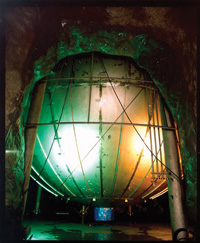Journey to the center of the Earth
 |
|
| Photo courtesy of KamLAND | |
Using an antineutrino detector based in Japan, researchers can tell what makes the Earth's interior hot and better understand the planet's workings.
Scientists designed KamLAND to detect and study antineutrinos produced in Japanese nuclear reactors. But they knew it could also measure antineutrinos produced by natural geological processes in the Earth, says Stuart Freedman of Lawrence Berkeley National Laboratory, who leads US participation in KamLAND. By studying these geoneutrinos, he says, “we tried to change what can be said about geology.”
Radioactive isotopes in the Earth's interior release geoneutrinos, producing heat. KamLAND reported the first evidence for geoneutrinos in 2005 and followed up with a better measurement in 2011. These results indicate that about half of Earth's heat comes from radioactive decays, an estimate based on accepted geophysical models.
Heat from Earth's interior not only drives the spreading of the ocean floors and the movement of the continents, it's also indirectly responsible for the magnetic field that protects the Earth's surface from cosmic rays and ozone-depleting particles from the sun.
But the geoneutrinos detected so far are assumed to come from the Earth's crust and mantle, not the core, and perhaps only from the upper mantle. “It's not clear we have much of any sampling from deeper,” says geophysicist Raymond Jeanloz of the University of California at Berkeley. “It would be very useful to get constraints on radioactive heat production in the core as well. For one thing, this would inform us about the energy sources that generate the geomagnetic field.”
To get those deeper measurements, scientists need to pinpoint the directions the geoneutrinos come from—a much debated proposition. That will require many more antineutrino detectors around the globe in locations such as the middle of the oceans, where Earth's crust is thinnest.
Paul Preuss
Click here to download the pdf version of this article.






